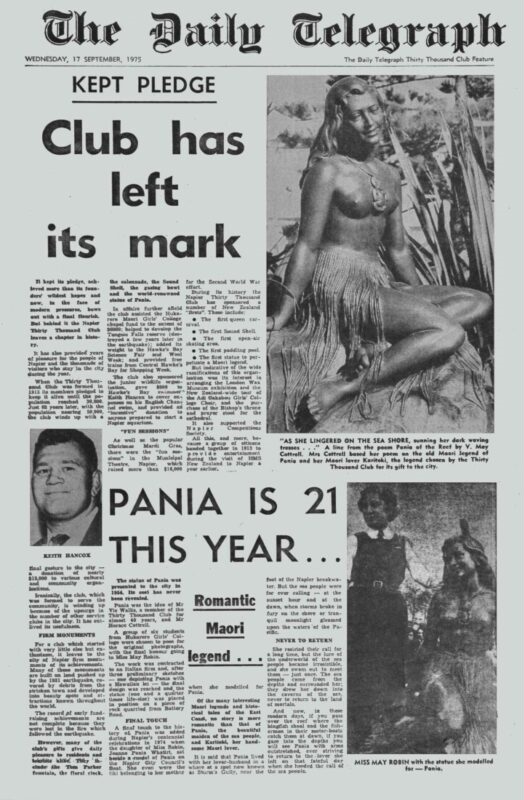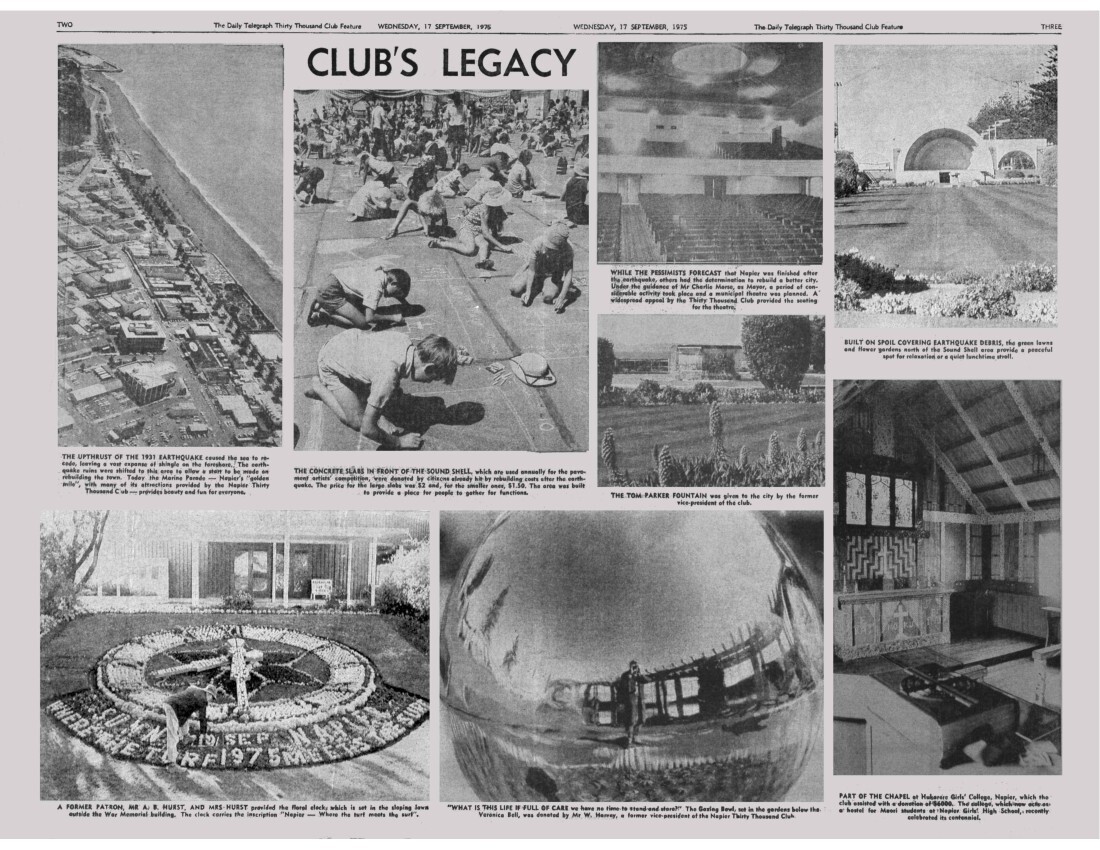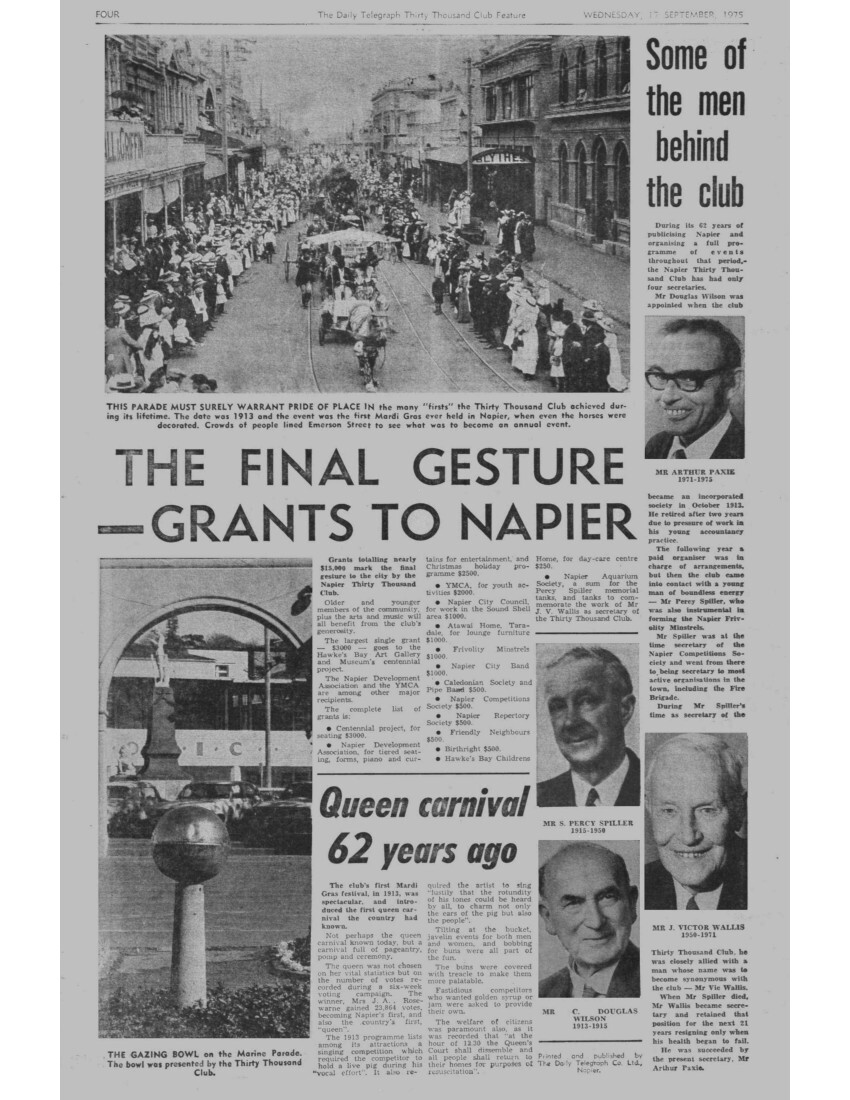The Daily Telegraph
WEDNESDAY, 17 SEPTEMBER 1975 The Daily Telegraph Thirty Thousand Club Feature
KEPT PLEDGE
Club has left its mark
It kept its pledge, achieved more than its founders’ wildest hopes and now, in the face of modern pressures, bows out with a final flourish. But behind it the Napier Thirty Thousand Club leaves a chapter in history.
It has also provided years of pleasure for the people of Napier and the thousands of visitors who stay in the city during the year.
When the Thirty Thousand Club was formed in 1913 its members pledged to keep it alive until the population reached 30,000. Just 62 years later, with the population nearing 50,000, the club winds up with a final gesture to the city – a donation of nearly $15,000 to various cultural and community organisations.
Ironically, the club, which was formed to serve the community, is winding up because of the upsurge in the number of other service clubs in the city. It has outlived its usefulness.
FIRM MONUMENTS
For a club which started with very little else but enthusiasm, it leaves to the city of Napier firm monuments of its achievements. Many of these monuments are built on land pushed up by the 1931 earthquake, covered by debris from the stricken town and developed into beauty spots and attractions known throughout the world.
The record of early fund-raising achievements are not complete because they were lost in the fire which followed the earthquake.
However, many of the club’s gifts give daily pleasure to residents and tourists alike. The include the Tom Parker fountain, the floral clock, the colonnade, the Sound Shell, the gazing bowl and the world-renowned statue of Pania.
In affairs further afield the club assisted the Hukarere Maori Girls’ College chapel fund to the extent of $6000; helped to develop the Tangoio Falls reserve (destroyed a few years later in the earthquake); added its weight to the Hawke’s Bay Science Fair and Wool Week; and provided free trains from Central Hawke’s Bay for Shopping Week.
The club also sponsored the junior wildlife organisation, gave $200 to the Hawke’s Bay swimmer Keith Hancox to cover expenses on his English Channel swim, and provided an “incentive” donation to anyone to start a Napier aquarium.
“FUN SESSIONS”
As well as the popular Christmas Mardi Gras, there were the “fun sessions” in the municipal Theatre, Napier, which raised more than $16,000 for the Second World War effort.
During its history the Napier Thirty Thousand Club has sponsored a number of New Zealand “firsts”. These include:
The first queen carnival.
The first Sound Shell.
The first open-air skating area.
The first padding pool.
The first statue to perpetuate a Maori legend.
But indicative of the wide ramifications of this organisation was its interest in arranging the London Wax Museum exhibition and the New Zealand-wide tour of the Adi Cakabou Girls College Choir, and the purchase of the Bishop’s throne and prayer stool for the cathedral.
It also supported the Napier Competitions Society.
All this, and more, because a group of citizens banded together in 1913 to provide entertainment during the visit of HMS New Zealand to Napier a year earlier.
PANIA IS 21 THIS YEAR…
Romantic Maori legend…
The statue of Pania was presented to the city in 1954. Its cost has never been revealed.
Pania was the idea of Mr Vic Wallis, a member of the Thirty Thousand Club for almost 40 years, and Mr Horace Cottrell.
A group of six students from Hukarere Girls College were chosen to pose for the original photographs, with the final honour going to Miss May [Mei] Robin.
The work was contracted to an Italian firm, and after three preliminary sketches – one depicting Pania with a Hawaiian lei – the final design was reached and the statue (one and a quarter times life-size) was placed in position on a piece of rock quarried from Battery Road.
FINAL TOUCH
A final touch to the history of Pania was added during Napier’s centennial celebrations in 1974 when the daughter of Miss Robin, Joanne Pania Whatiri [Whaitiri], sat beside a model of Pania on the Napier City Council’s float. She even wore the tiki belonging to her mother when she modelled for Pania.
Of the many interesting Maori legends and historical tales of the East Coast, no story is more romantic than that of Pania, the beautiful maiden of the sea people, and Karitoki, her handsome Maori lover.
It is said that Pania lived with her lover-husband in a whare at a spot now known as Sturm’s Gully, near the foot of the Napier breakwater. But the sea people were for ever calling – at the sunset hour and at the dawn, when storms broke in fury on the shore or tranquil moonlight gleamed upon the waters of the Pacific.
NEVER TO RETURN
She resisted their call for a long time, but the lure of the underworld of the sea people became irresistible, and she swam out to meet them – just once. The sea people came from the depths and surrounded her; they drew her down into the caverns of the sea, never to return to the land of mortals.
And now, in these modern days, if you pass over the reef where the kingfish shoal and the fishermen in their motor-boats catch them at dawn, if you gaze into the depths you will see Pania with arms outstretched, ever striving to return to the lover she left on that fateful day when she heeded the call of the sea people.
Photo captions –
KEITH HANCOX
“AS SHE LINGERED ON THE SEA SHORE, sunning her dark waving tresses…” A line from the poem Pania of the Reef by V. May Cottrell. Mrs Cottrell based her poem on the old Maori legend of Pania and her Maori lover Karitoki, the legend chosen by the Thirty Thousand Club for its gift to the City.
MISS MAY ROBIN with the statue she modelled for – Pania.














Do you know something about this record?
Please note we cannot verify the accuracy of any information posted by the community.